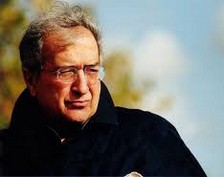
Luciano Berio (1925–2003, Italy) received his first lessons in music from his grandfather and father – organists and composers. After the war, he entered the Verdi Conservatory in Milan, studying at first with Paribeni (counterpoint and fugue), then with Ghedini (composition), and Votto and Giulini (orchestral conducting). He earned his living as an accompanying pianist, meeting this way his first wife, American singer Cathy Berberian, with whom he was to explore the possibilities of voice in numerous works, most notably Sequenze III(1965). In 1952 at Tanglewood he studied with Luigi Dallapiccola, whom he greatly admired, as could be seen in the dedication of Chamber Music (1953). In Basel, attending one of the conferences devoted to electroacoustic music, he met Stockhausen, composing after that his first pieces for tape (Mimusique no. 1). In Darmstadt, Berio met Boulez, Pousseur, and Kagel, and his personal response to serialism came in Nones (1954). He returned to Darmstadt more than once, teaching there in 1960; nonetheless, he kept his distance from the dogmatic ambience that prevailed there. With Bruno Maderna in 1955, he founded the Studio for Music Phonology at the Milan RAI. These explorations gave rise to Thema (Ommagio a Joyce) in 1958. Passionately interested in instrumental virtuosity, in 1958 he started his series of Sequenze, which he finished in 2002. From 1960 on he taught composition in the USA at the Summer School in Dartington, Mills College, Harvard University, Columbia University, and Julliard School of Music, where in 1967 he founded Juilliard Ensemble, specialised in contemporary music. Upon his return to Europe in 1972, Boulez invited him to manage the department of electroacoustic music at IRCAM (1974–1980). During the 1980s, Berio realised two major operatic projects – La Vera Storia (1982) and Un re in ascolto (1984), on libretti by Italo Calvino. Apart from his creative activities, Berio was constantly engaged at various Italian and international institutions. His international fame was acknowledged with numerous prizes, awards, and honours, such as Leone d’Oro at the Venice Biennale (1995) and Premium Imperiale (Japan, 1999).
Written in 2001, Piano Sonatabelongs to Berio’s final creative period. The work was premièred by Andrea Lucchesini at the Zurich Festival in July 2001. In his short commentary included in the programme booklet, Berio wrote: “Every Sonata, regardless of where and when it was composed, initiates and develops, always and in each individual case, a dialogue among various characters of expression, structural identities and techniques, continuities and breaks, the simple and the complex, presence and absence… In my Sonata, that dialogue is in there, but its distribution in the sonata’s timeframe, that is, its syntax, is indifferent to the nature of expressive characters”. The dialogue to which Berio refers may be viewed in two ways: as internal (between the numerous, heterogeneous elements of the Sonata’s structure – powerful chordal sequences, lyrical sections, virtuosic repetition, different variation procedures, and numerous contrasting characters) as well as external – the Sonata communicates, that is, explores and re-examines the meanings of modernist tendencies in 20th-century music, by using three chords that marked the epoch: the Tristan chord, the poly-chord from Stravinsky’s Rite of Spring, and Stockhausen’s chord from Klavierstück IX.


